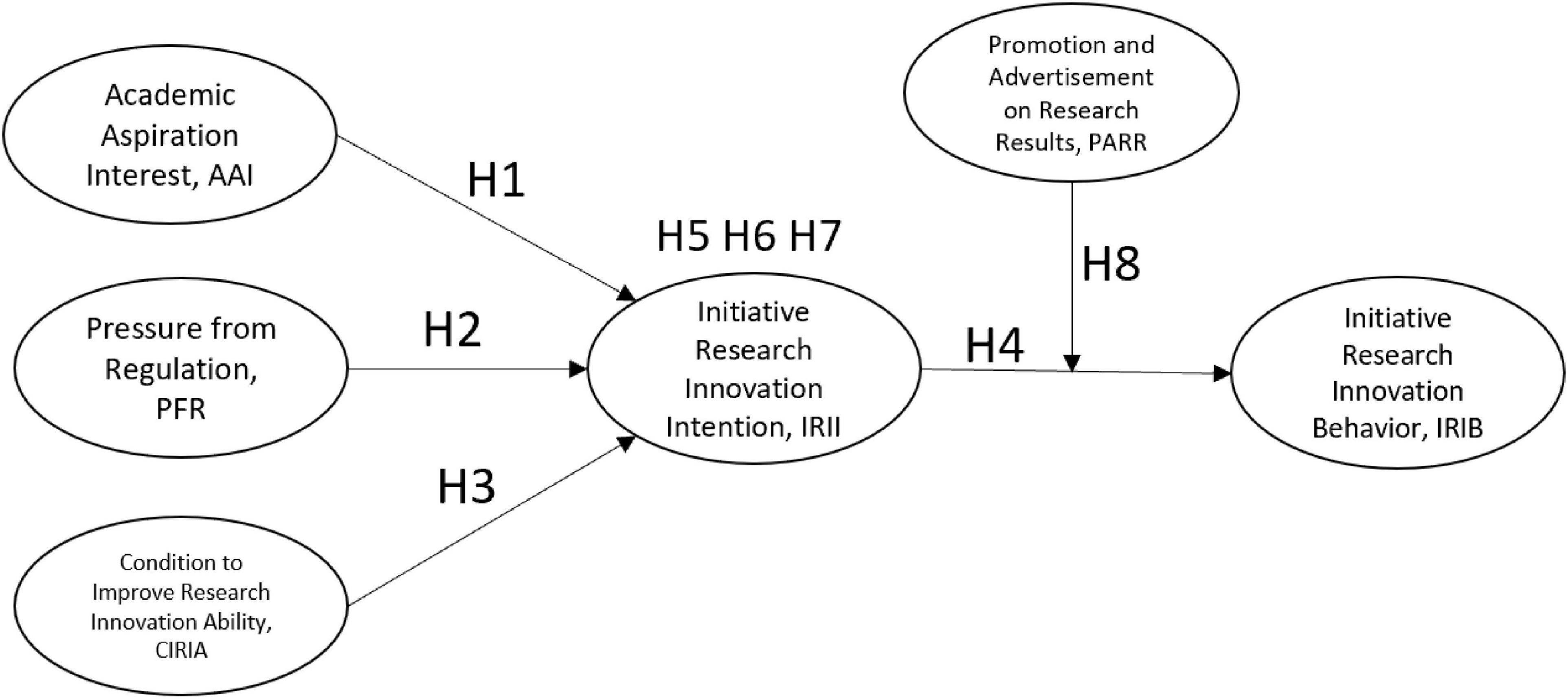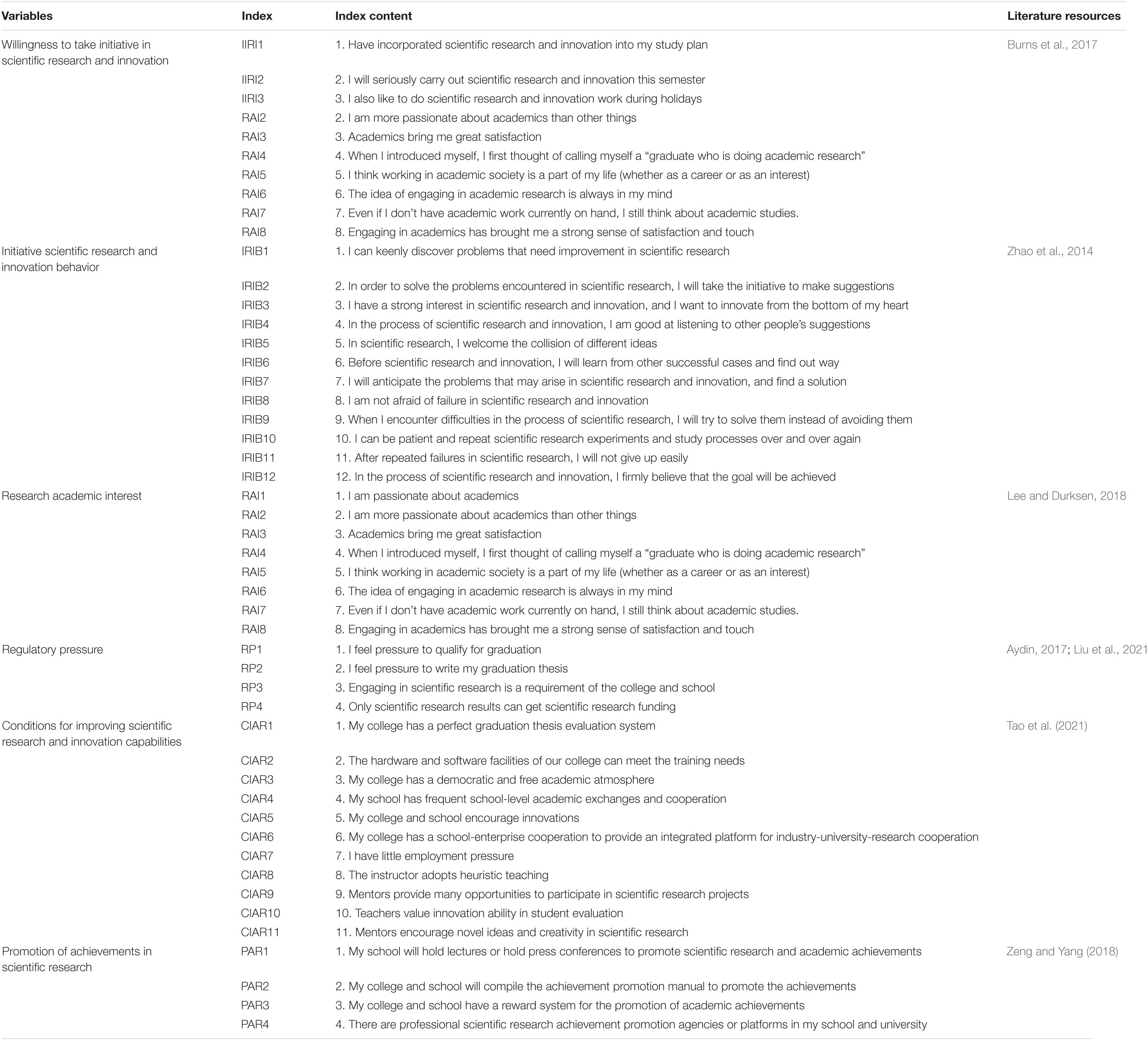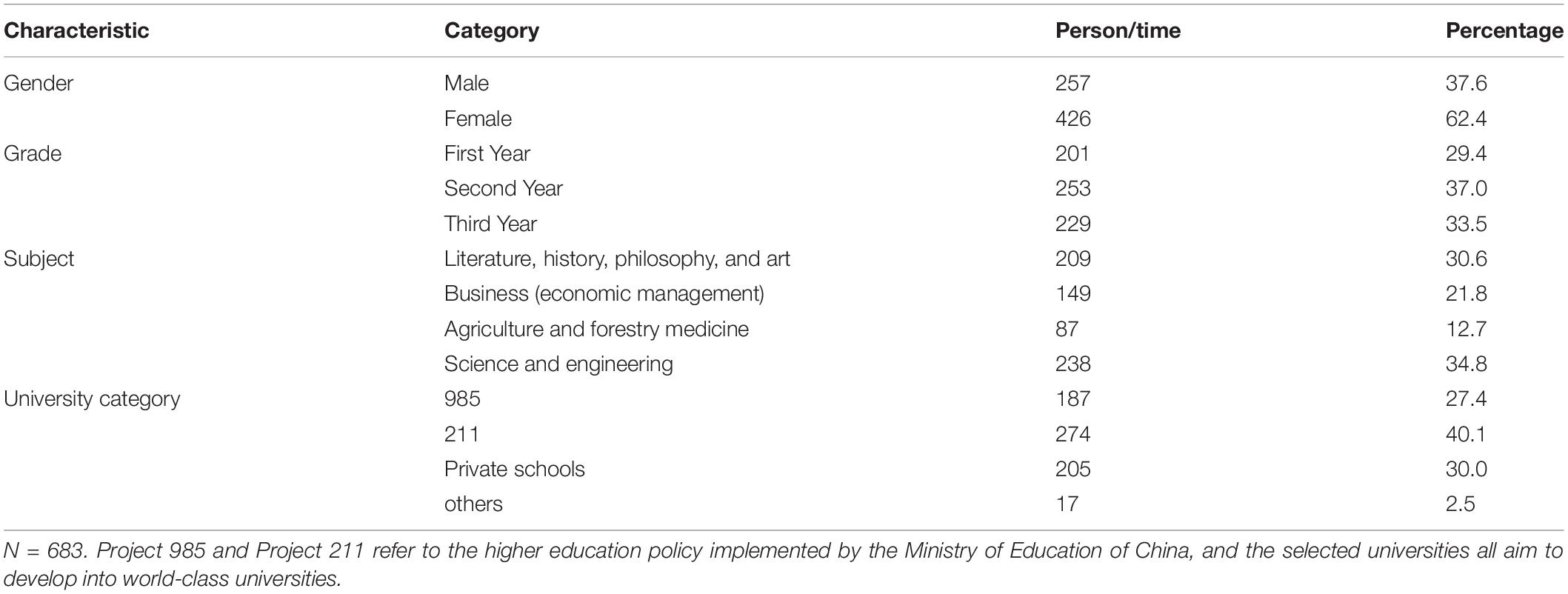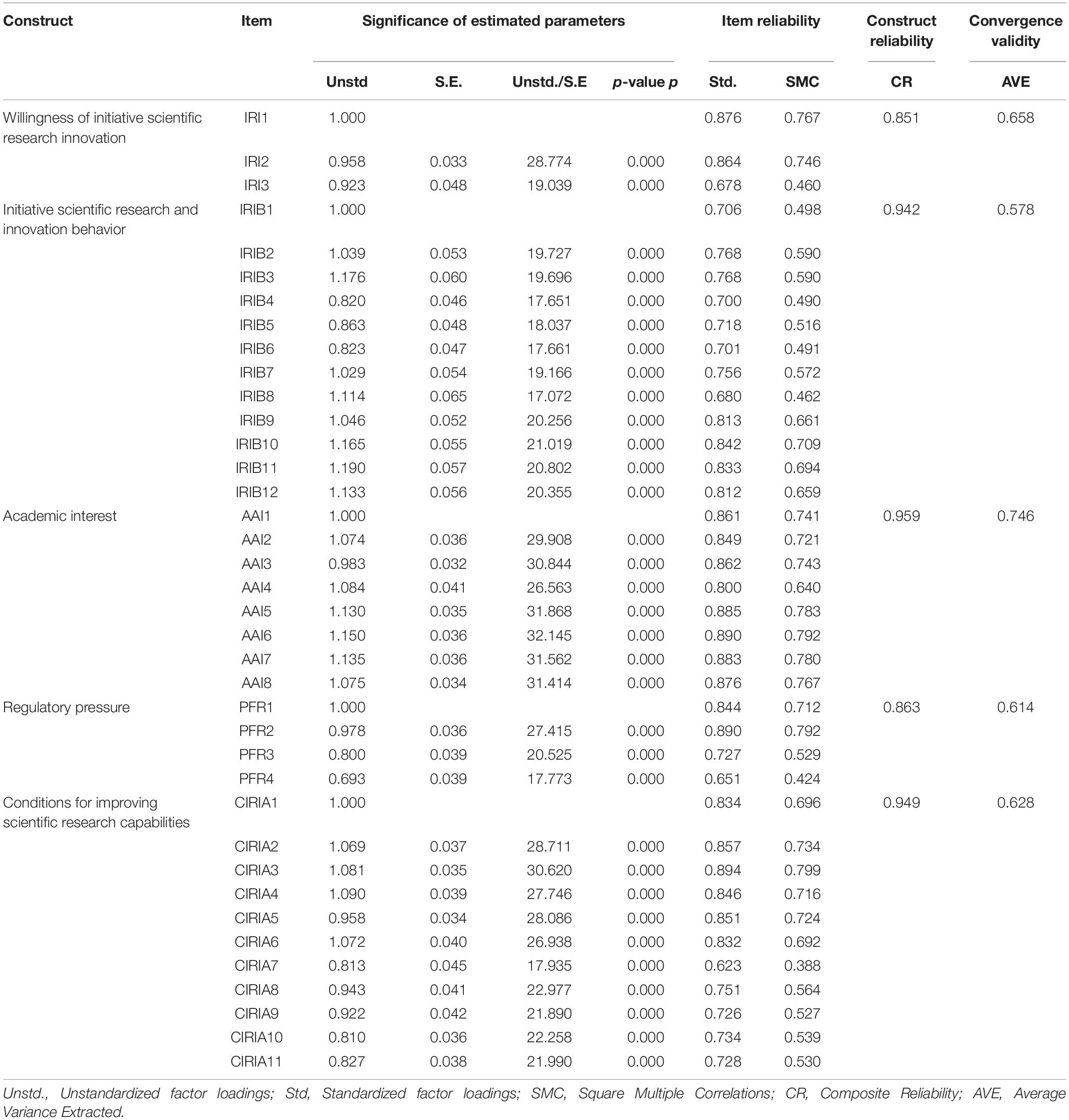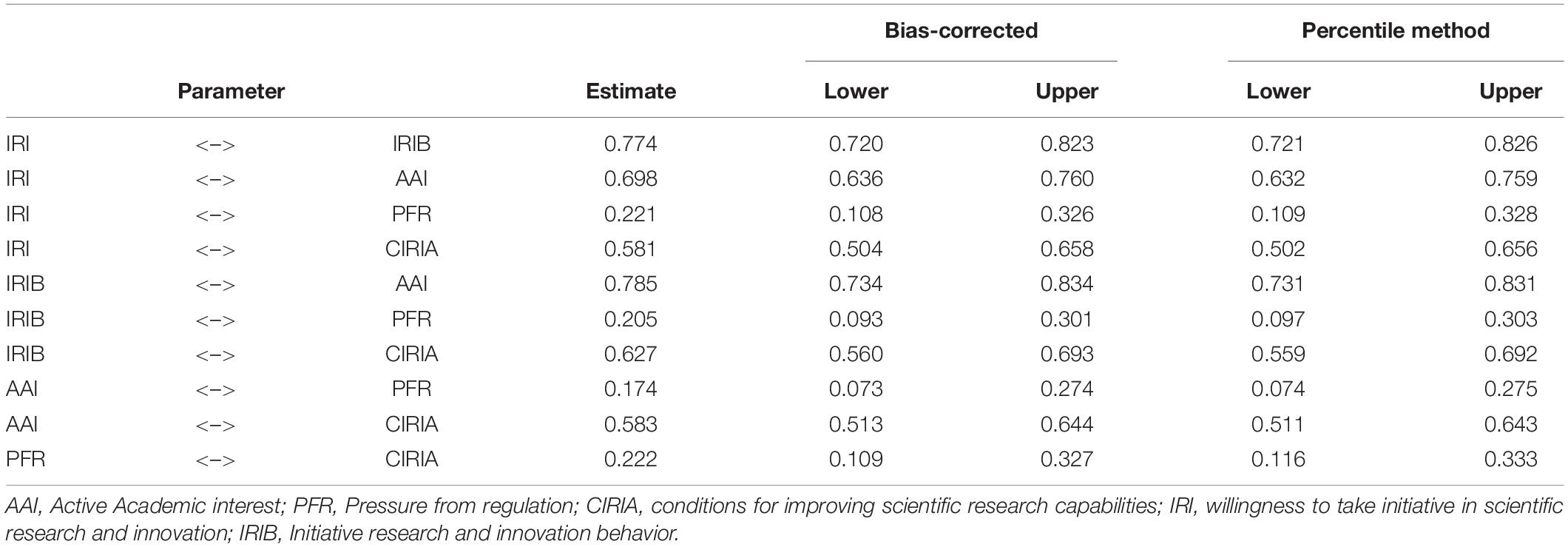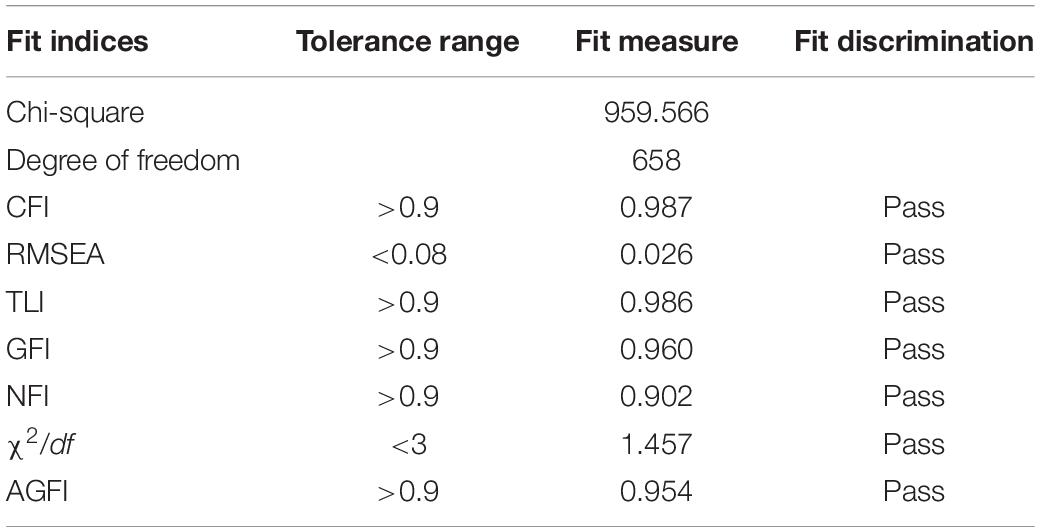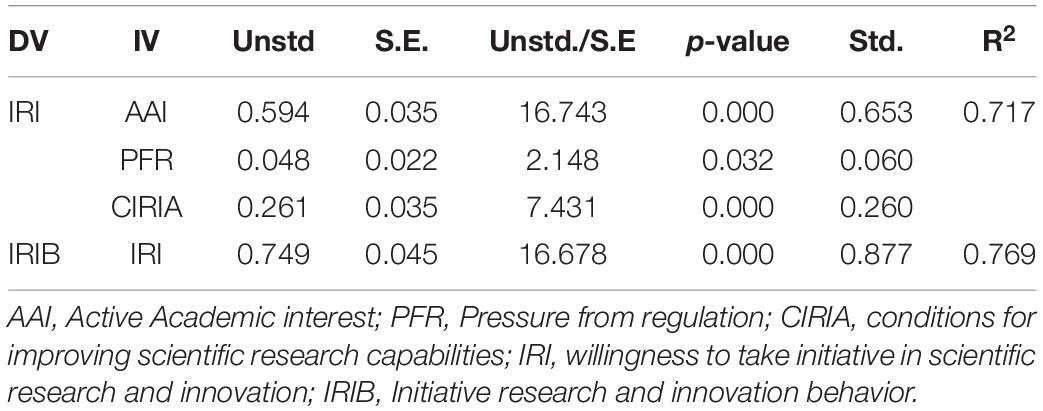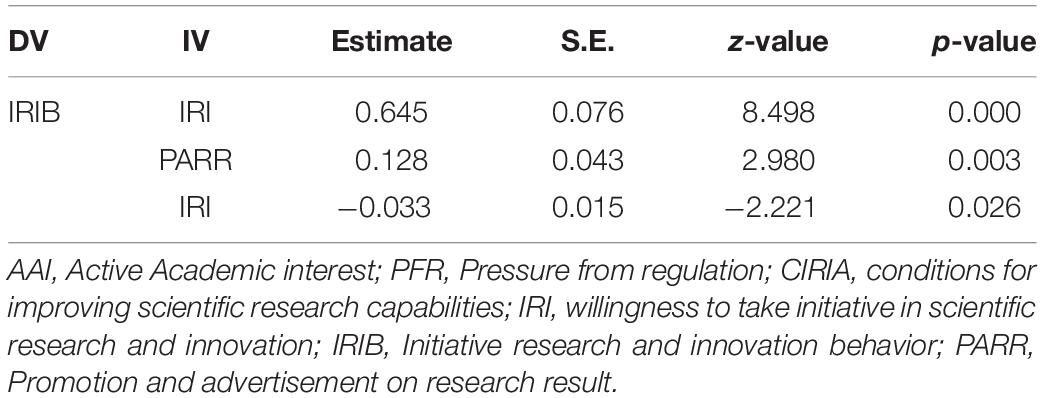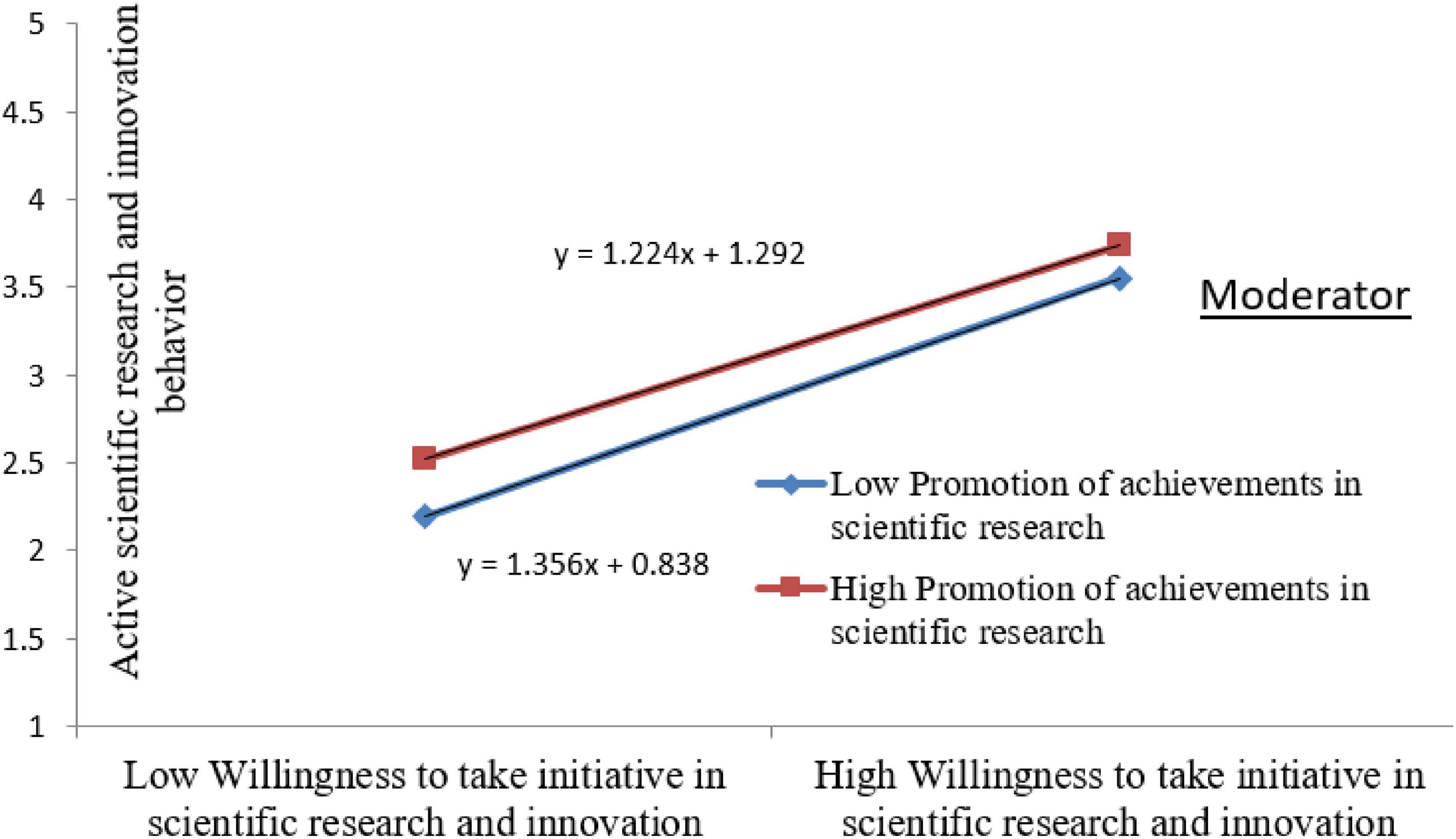- 1Tourism School, Hainan University, Haikou, China
- 2Zhongyuan Design Group, Haikou, China
- 3Tourism School, Hainan University, Haikou, China
To clarify the generative mechanism and influencing factors of graduate students’ willingness and behavior of initiative scientific research and innovation, this research builds a quantitative model consisting of six variables: academic interest, regulatory pressure, conditions for improving scientific research and innovation capabilities, willingness to take initiative in scientific research and innovation, the promotion of achievements in scientific research, and initiative scientific research and innovation behavior. In total, 684 valid questionnaires were distributed and collected through WeChat Moments. Descriptive statistical analysis, reliability and validity analysis, factor analysis, path analysis, and conditioning analysis were conducted using the SPSS and structural equation model (SEM). The results showed that: (1) academic interest, regulatory pressure, and conditions for improving scientific research and innovation capabilities have a positive impact on the intention of initiative scientific research and innovation, but the impact of regulatory pressure is extremely insignificant. (2) The willingness to take initiative in scientific research and innovation has a positive and significant impact on initiative scientific research and innovation behavior, and the promotion of achievements in scientific research plays a negative moderating effect. Finally, this manuscript puts forward the suggestions on how to promote the initiative scientific research and innovation behavior of postgraduate students based on the research results.
Introduction
Postgraduate education plays an important role in cultivating innovative talents, improving innovation capabilities, serving economic and social development, and cultivating innovative talents required for high-quality economic and social development, emphasized by the Chinese President Xi (2020). In an increasingly competitive society, it is essential to cultivate the creativity of graduate students (Baglin et al., 2017). The scientific research ability is a key indicator to measure the quality of graduate education, and the scientific research and innovation capabilities of postgraduate students is the core component of the innovation ability of graduate students. Building a perfect training system for graduate students’ scientific research and innovation capabilities has increasingly become a major focus of the academic circles (Haddad et al., 2021).
With the profound changes in the China’s economic development mode, the implementation of an innovation-driven national strategy requires the training of a large number of innovative talents. The Ministry of Education of China (MOE) divides higher education levels into: postgraduate (doctorate/master), undergraduate in regular Higher Education Institutions (HEIs), undergraduate in adult HEIs, and undergraduate in online HEIs; among them, master postgraduate students can be divided into master program under central ministries (MOE/other departments), local authorities (MOE/other departments), non-governmental sectors, and Chinese-foreign cooperatively run schools with corporate capacity. There are a total of 2,673,049 postgraduate students of various types. With the expansion of the scale of enrollment, the phenomenon of postgraduate students with academic level of undergraduates has begun to emerge from the water (Wen, 2020). Postgraduates have the problems of low scientific research abilities, poor practical ability, and insufficient innovation ability (Iqbal and Mahmood, 2010).
Postgraduates’ own factors are an important constraint on the cultivation of their scientific research capabilities, such as learning methods, cognitive ability, and volitional quality (Tao et al., 2020). At the same time, tutors and their training design are undoubtedly the key factors influencing the cultivation of postgraduates’ scientific research capabilities. Factors, such as social capital of graduate students’ classmates and family members (Brodin, 2018), the academic community among the students with the same or similar academic pursuits and value orientation, the resulting academic interactions (Meng et al., 2017), the outstanding research ability of the research team leader (Boni et al., 2009), the e-learning adoption (Schneckenberg, 2009), all affect the cultivation of graduate students’ scientific research capabilities. Related research mainly based on the field of pedagogy reveals the law of the cultivation of graduate students’ scientific research capabilities. However, as a microcosmic subject, graduate students’ innovation capacities are dynamic, complex, and diverse. It is very necessary to initiate a discussion based on psychology, behavioral sciences, and other micro-levels, but it has not attracted sufficient attention from scholars.
This manuscript focuses on the microcosmic subjects, innovatively introduces the concept of initiative scientific research and innovation, selects the theory of planned behavior (TPB) and system innovation theory, and complements the moderating effect of the variable “promotion of research achievements” on the basis of TPB model, so as to clarify the generative mechanism and influencing factors of graduate students’ willingness and behavior of initiative scientific research and innovation, and to provide suggestions for effectively stimulating the practice of graduate students’ initiative scientific research and innovation behavior based on the conclusion of quantitative model research.
Theoretical Background and Hypothesis Development
Theoretical Background
Innovation Theory
Innovation can be divided into technological innovation and institutional innovation. The principle of innovation theory plays a fundamental role in the interpretation of innovative subjects, behaviors, and activities. According to collaborative innovation theory, under the framework of the national innovation strategy system, the four-in-one organizational structure of government, industry, university, and research, the government actively coordinates the organizational resources and integrates innovative subjects with completely different functions, such as universities, enterprises, research institutes, and intermediaries, so as to give full play to their respective advantages and organically integrate into an effective innovative subsystem (Aydin, 2017). Promoting the cooperation of innovative subsystems through the promotion of achievements in scientific research is a powerful means of system innovation in scientific research and innovation.
Theory of Planned Behavior
Theory of planned behavior is derived from the theory of reasoned action (TRA), which was proposed by Fishbein and Ajzen to analyze how people change their behavior patterns through personal willingness. Ajzen proposed the TPB. TPB is one of the most persuasive theories for studying behavioral willingness and its antecedents. The theory points out that behavior is the result of its own rational thinking, and its variables include attitude, subjective norms, and perceived behavioral control (Fishbein and Ajzen, 1975). Attitude refers to an individual’s positive or negative feelings toward a behavior, and is the view and evaluation of the implementation of a specific behavior; subjective norms are the views and opinions on the social pressure when engaging in specific behaviors; and perceived behavioral control refers to the degree of ease or difficulty an individual perceives to achieve a particular behavior, which reflects the subject’s perception of factors helping or hindering the behavior and their influence (Rana et al., 2019).
Hypothesis Development
Academic Interest and Willingness of Initiative Scientific Research Innovation
Initiative Scientific Research Innovation
Innovation, as inventiveness grounded in field-specific knowledge and expedited by motivation, is related to creativity, novelty, implementation, and entrepreneurship (Tierney and Lanford, 2016). Scholars argued that in his empirical research: the innovation behavior of scientific and technological personnel can be divided into passive and initiative behaviors; spontaneity, preliminary preparation, and overcoming obstacles are the core elements of initiative innovation behavior (Casati and Genet, 2014). Since initiative scientific research and innovation subjects are spontaneous, well-prepared and not afraid of setbacks, their behavior is of great significance to high-quality and valuable scientific research and innovation output.
Academic Interest
Academic interest, broadly defined as personal orientations toward activities that are intended to develop one’s academic skills and knowledge (Lee and Durksen, 2018), has been linked to better academic performance (Lee and Shute, 2010). Burch’s student involvement theory states that the effective participation of doctoral students in the scientific research process requires not only their participation at the action level, but also the input of the thinking, which mainly refers to the interest in the process of participating in academic activities; moreover, interest can promote students’ personal development while participating in the scientific research (Burch et al., 2015). Additionally, scholars paid attention and proved that interest is essential to engagement (Bazeley, 2010) and autonomy (Tierney and Lanford, 2016) that are necessary for innovation.
To sum up, as an internal and lasting motivation, academic interest has a positive impact on the willingness to take initiative in scientific research and innovation. For graduate students, the higher the academic interest, the stronger the willingness to take initiative in scientific research and innovation. Based on this, we put forward the following research hypotheses:
Hypothesis 1. Academic interest has a positive and significant impact on the willingness of initiative scientific research innovation.
Regulatory Pressure and Willingness of Initiative Scientific Research Innovation
Regulatory elements are important institutional variables, which is a clearly stipulated rule that must be followed. Lots of research showed that institutional variables are closely related to the research productivity (Teodorescu, 2000). The regulatory rules are accompanied by corresponding rewards and punishments. Organizations or members of society respond to them out of instrumental logic rights (Wamala and Ssembatya, 2015). The core manifestation of regulatory elements is policies and rules, which infer the behaviors that “have to do,” and the emotional support for the regulated objects can be fear, guilt, or innocence and ease (Hedjazi and Behravan, 2011; Fang and Fu, 2014). Regulatory pressure refers to the pressure brought on by external policies and regulations that require postgraduate students to carry out scientific research and innovation.
Scholars argue that school management is a key element of the research performance. Management and the culture related to university research work have an impact on the effect of scientific research (Edgar and Geare, 2013). It is stated that the quantity and quality of academic papers published by training units are linked with academic degrees, and the establishment of minimum academic standards for graduation and training plans creates a regulatory environment for scientific research, in which postgraduate students “have to” conform to the regulatory environment and have the motivation to complete their learning tasks of scientific research. Through quantitative research, the author points out that the regulatory pressure has a significant positive impact on graduate students’ research innovation motivation (Li et al., 2021).
To sum up, as an external and mandatory factor influencing graduate students’ willingness to scientific research and innovation, regulatory pressure has a positive impact on their willingness to scientific research and innovation. The greater the regulatory pressure, the stronger the willingness of scientific research and innovation. Based on this, we put forward the following research hypotheses:
Hypothesis 2. Regulatory pressure has a positive and significant impact on the willingness of postgraduates in scientific research and innovation.
Conditions for Improving Scientific Research Capabilities and Willingness of Initiative Scientific Research Innovation
Scientific research and innovation capabilities are the core of scientific research, such as people’s ability to explore unknown things, ability to discover new knowledge, and ability to apply new technologies (Tierney and Lanford, 2016). To measure the researchers’ capacity for scientific research, the internal quality and external scientific research results are mainly adopted. Internal quality mainly includes research ethics, methods and skills, scientific thinking, and research implementation ability (Zhang et al., 2011). The improvement of scientific research ability is affected by many factors, and the condition of these factors is the condition for improving the scientific research ability of graduate students.
When analyzing the influencing factors of graduate students’ scientific research and innovation, the advisor factors, such as academic status, academic experience, and allocation of energy show great association with doctoral graduate performance (McAlpine et al., 2020). At the same time, training and experience, opportunity and resources are proved to be the further pre-conditions for research performance (Bazeley, 2010). Tao Yuchun and others confirmed through quantitative research that factors, such as open academic environment, social support and guidance, tutor team, and innovation achievements have a significant impact on graduate students’ innovative ability (Tao et al., 2021).
In conclusion, high performance in research field need some circumstances, such as management and culture, as well as pre-conditions, such as knowledge foundation, these are the conditions for research work. Good conditions for improving scientific research ability are conducive in giving postgraduate students an excellent foundation for innovation ability, and will boost graduate students’ confidence in scientific research and innovation; otherwise, it will restrain the innovation abilities of graduate students. Based on this, the research hypothesis is proposed as follows:
Hypothesis 3. The ability of scientific research and innovation has a positive and significant impact on graduate students’ willingness to innovate in scientific research.
Hypothesis Based on the TBP
Corresponding academic interests to attitudes, regulatory pressures to subjective norms, and conditions for improving scientific research capabilities to perceptual behavior control, referring to the TPB theory, and the following research hypotheses are proposed:
Hypothesis 4: The behavioral intention of initiative scientific research and innovation has a positive and significant impact on initiative scientific research and innovation behavior.
Hypothesis 5: Academic interest has a positive and significant impact on initiative scientific research and innovation behavior through the behavioral intention of initiative scientific research and innovation.
Hypothesis 6: Regulatory pressure has a positive and significant impact on initiative scientific research and innovation behavior through the behavioral intention of initiative scientific research and innovation.
Hypothesis 7: Conditions for improving scientific research capabilities have a positive and significant impact on initiative scientific research and innovation behavior through the behavioral intention of initiative scientific research and innovation.
Moderating Effect
The interaction and communication between scholars and community are always considered as important variables leading to high performance in research work. A higher degree of interaction with other researchers (Kyvik and Smeby, 1994), professional networks (Brocato, 2001) and the network of communication with colleagues (Hedjazi and Behravan, 2011; Aydin, 2017) are paid attention to when research performance is studied. At the same time, to high-performance researcher, the meaning of being a researcher is the awareness of respect, concrete products (publication and citation), academic standing, and personal understanding and benefits to the community (Akerlind, 2008). The core issue of scientific research is not only to pursue the advancement of scientific research achievements, but also to pursue the transformation, promotion, and application of scientific research results. If scientific research is innovative, if it is not popularized, it will have no practical effect on the national economy and life. The transformation of scientific and technological achievements refers to the activities of subsequent testing, development, application, and popularization of scientific and technological achievements with practical value resulting from scientific research and technological development to the formation of new products, new processes, and new materials and the development of new industries for the purpose of improving the level of productive forces (Lite, 2019).
It is indicated that based on the selection of outstanding scientific research achievements, the government and administrative departments need to pay attention to the publicity and promotion of the achievements, and promote the higher level of scientific research through the establishment of results compilation and promotion, conference promotion, network platform promotion, and training promotion, etc. (Zeng and Yang, 2018).
Moderating variables are variables that affect the intensity and direction of the independent variables and dependent variables. The significance of the moderating variables is to identify the boundary conditions of the independent variables corresponding to the variables.
In summary, the promotion of achievements in scientific research will have an impact on the level of scientific research and the advancement of scientific payoffs, and scientific research and innovation behavior is a necessary component of the level and advancement of scientific research. The influence of the intention of initiative research innovation behavior on the initiative research innovation behavior will be interfered by the promotion of achievements in scientific research, which is the moderating variable of the model and plays a conditional role. Based on this, the research hypothesis is proposed as follows:
Hypothesis 8. The promotion of achievements in scientific research has a moderating effect on the relationship between behavioral intention of initiative scientific research and innovation and initiative scientific research and innovation behavior.
Based on the above assumptions, this study constructs the research model shown in Figure 1.
Research Method and Material
Sample and Procedure
This study focused on Chinese academic postgraduate students. A total of 684 students were selected. An online survey through the App of Wechat was conducted by inviting qualified postgraduate students to fill in and distribute the electronic questionnaire to the corresponding graduate class group. Rather than asking respondents simply whether they agree or accept an opinion statement, Likert scale items asked how strongly they agree or disagree with it, usually on a 7-point scale from 1 (= strongly disagree) to 7 (= strongly agree), with 4 being a neutral feeling or category. From September 10 to September 17, 2021, the research team distributed questionnaires through WeChat moments inviting qualified postgraduate students to fill in and distribute them to the corresponding graduate class group, excluding 83 questionnaires with incomplete fillings and inconsistent answer options, and finally recovering 684 valid questionnaires.
Questionnaire Design
Composition of the Questionnaire
The research questionnaire is divided into two parts: the first part is the willingness and behavior of initiative research and innovation of postgraduate students and its influencing factors, which can be divided into seven dimensions, such as the willingness of initiative scientific research and innovation, initiative scientific research and innovation behavior, academic interest, regulatory pressure, scientific research and innovation capabilities, conditions for improving scientific research and innovation capabilities, and promotion of scientific research achievements. The questionnaire is designed using a Likert’s seven-level scale. In this scale, “1” means strongly disagree, and “7” means strongly agree. The second part is the basic personal information of the respondents, such as gender, grade, professional category, and school category. After the questionnaire design is completed, it was reviewed by industry experts and scholars, and was gradually revised to perfection.
Item Design of Latent Variable Measurement
Item Design of Variable Measurement Questions for the Willingness to Take Initiative in Scientific Research and Innovation
Mainly referring to the indicators in the research of Michael E. Burns et al. (2017) on the influence of positive evaluation factors of tutors on the positive interaction mode between students and teachers, combined with the research scene of initiative research willingness, referring to the index system of students’ willingness to initiatively interact with teachers, the index content of this variable is rewritten as follows: whether the scientific research and innovation work is included in the study plan, whether the scientific research and innovation work will be carried out seriously in the current period, and whether the scientific research work is also liked during holidays.
Item Design of Variable Measurement of Initiative Scientific Research and Innovation Behavior
In the research on the concept definition and scale development of scientific and technical personnel’s initiative innovation behavior, Zhao et al. (2014) designed 4 first-level indicators and 27 observable values related to scientific and technical personnel’s initiative innovation behavior, removing 5 values in the research that have been quantified and proved to be insignificant, combined with the research and innovation behavior of graduate students, this manuscript selected 12 indicators based on the research.
Academic Interest
In Bohan et al. (2019) designed 10 indicators corresponding to academic interest and life ambition in their research on the influencing factors of academic postgraduates’ academic interests, Lee and Durksen (2018) studied the dimensions of academic interest among undergraduate students. Referring to Lee’s indicator system, combined with Liu’s focus, this manuscript selected 8 indicators from 10 indicators in the academic interest measurement of postgraduates, reducing two indicators related to ambitions in life, constructed an index to measure the academic interest of postgraduates.
Regulatory Pressure
In Liu et al. (2021) studied the impact of the scientific research incentive system on graduate students’ innovative motivation taking self-efficacy as an intermediary factor. Four items were designed to measure the regulatory pressure on graduate students’ innovation. Aydin (2017) looked into the research performance of higher education institutions and developed the questions about the features of institutional structure. This manuscript directly used this indicator system for reference.
Conditions for Improving Scientific Research and Innovation Capabilities
In Tao et al. (2021) conducted a research on the influencing factors of the innovation capacities of postgraduate students in Jiangxi Province, and measured the conditions for improving scientific research ability from the aspects of open academic environment, social support and guidance, and tutor team. This manuscript drew on 11 measurement indexes in the research.
Promotion of Achievements in Scientific Research
In Zeng and Yang (2018) conducted research on the mission, basic characteristics, and promotion strategies of strong scientific research universities. They evaluated the promotion of achievements in scientific research from two aspects: the form of promotion of achievements in scientific research and the promotion and reward systems. This manuscript drew on the four measurement indicators designed by the research.
To sum up: The final questionnaire contains 6 dimensions, and 48 measurement indicators, which are shown in Table 1 below.
Data Analysis
The data analysis of this study is carried out in three stages: descriptive analysis, measurement model verification, and SEM. Descriptive statistics includes statistical analysis of population variables, as well as calculating the mean and SD of each variable to understand the degree of concentration of the variables; then, two-step analysis is used to carry out the measurement model and the structural model (Anderson and Gerbing, 1988), and confirmatory factor analysis (CFA) is performed to confirm the reliability and validity of the item, such as the composite reliability is used to measure the degree of internal consistency of various variables, convergent validity, and discriminant validity.
In the third stage, the SEM was used for analysis to test the goodness for fit of the research model, and then to verify the various hypotheses of the research framework. The SEM includes factor analysis, path analysis, and moderate effect analysis.
Descriptive Statistics
The basic data of this research includes four items: gender, grade, major, and school level (as shown in Table 1). Among them, the gender is mainly female, with 426 students accounting for 62.4%; the grade is mainly the second year, with 253 students accounting for 33.51%; the major is mainly science and engineering, with 238 students accounting for 34.8%; the school level is mainly Project 211 (Project 985 and Project 211 refer to the higher education policy implemented by the Ministry of Education of the People’s Republic of China, 2020, and the selected universities all aim to develop into world-class universities), with 274 students accounting for 40.1% as Table 2 below shows.
Reliability and Validity Analysis
As shown in the table below, the standardized factor loading of the model is between 0.623 and 0.894, which is within the range, showing that each item has item reliability, acccording to Nunnally and Bernstein (1994) and Chin (1998); the construct reliability of the research variables is between 0.851 and 0.959, all exceeding 0.7. All meet the standards recommended by scholars, showing that each variable has good internal consistency; finally, the average variance extracted range is 0.578–0.746, higher than 0.5, meeting the standards proposed by Fornell and Larcker (1981) and Hair et al. (1998), showing that each variable has good convergent validity as Table 3 below shows.
Confidence interval (CI) is used to test the discriminant validity, according to Bootstrap, the two dimensions are discriminative valid when the CI is less than 1 (Torkzadeh et al., 2003). In this research, the bias-corrected and percentile method are used to test the CI and the result is shown as the following Table 4, all the CIs are less than 1, which shows that all dimensions are discriminative valid.
Fit Analysis
In this study, the fit index refers to 194 SSCI papers discussed by Jackson et al. (2009), which serve as the blueprint for the analysis of model fit, and the most extensive nine fit indexes are used by this manuscript. Since the SEM sample is larger than 200, it is easy to cause the chi-square value to be too large and lead to poor fit, so the fit value needs to be corrected by the Bootstrap method (Bollen and Stine, 1992). The comparison table of the fit degree results of the Bollen-Stine Bootstrap modified model is shown in Table 5. Applying the Bollen-Stine Bootstrapping method, the goodness of fit index of this research shows that the results of this research are acceptable mode.
Structural Equation Model Analysis
Path Analysis
The path coefficient results can be seen from the Figure 2 and Table 6 below. The research results support the research questions of this model. The interpretation effect of academic interest, regulatory pressure, and conditions for improving scientific research capabilities for the willingness to take initiative in scientific research and innovation is 71.7%. The interpretation effect of willingness to take initiative in scientific research and innovation for initiative scientific research and innovation behavior is 76.9%.
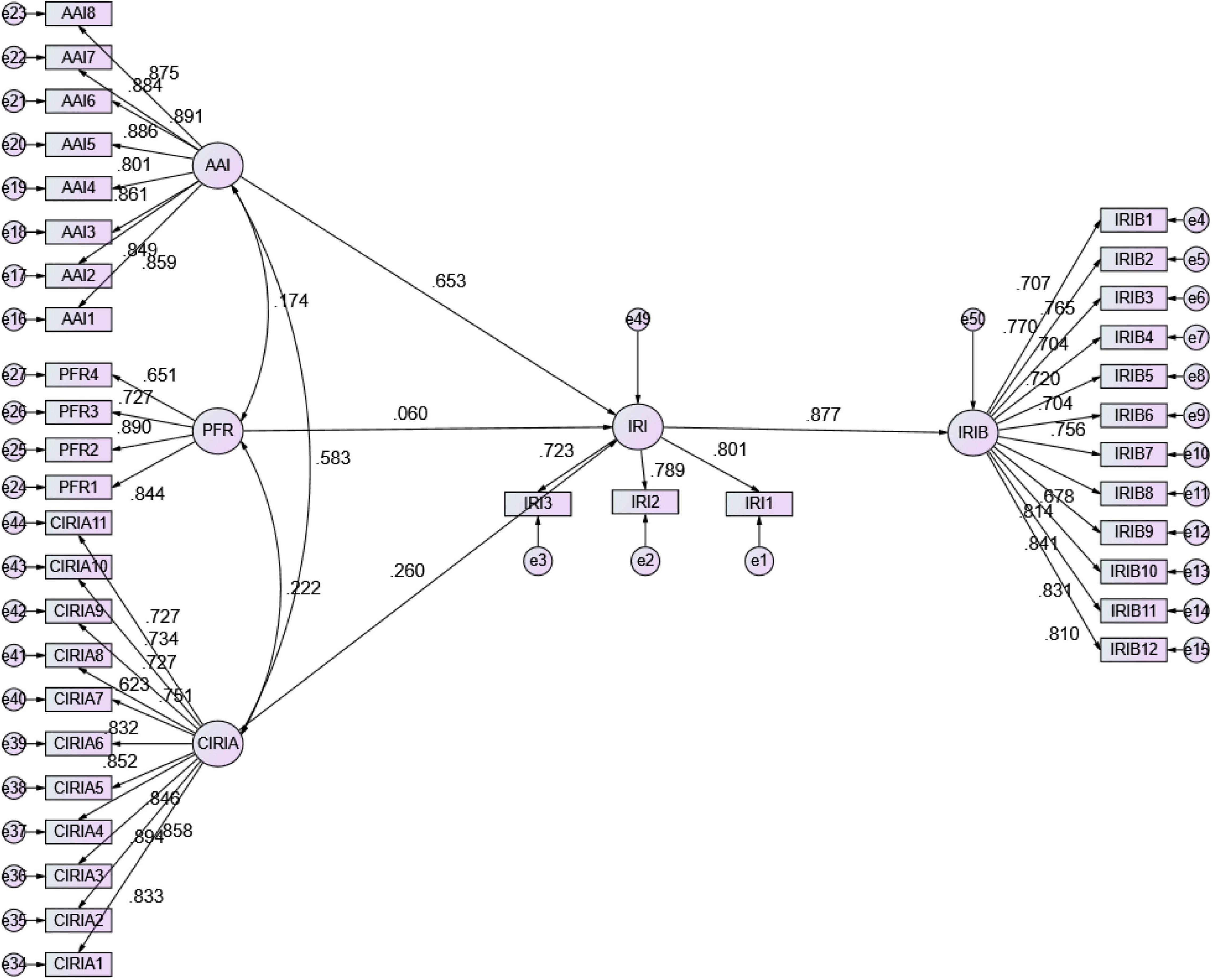
Figure 2. Statistical model diagram. AAI, Academic interest; PFR, regulatory pressure; CIRIA, conditions for improving scientific research capabilities; IRI, willingness to take initiative in scientific research and innovation; IRIB, initiative scientific research and innovation behavior.
Mediation Effect and Moderation Effect Analysis
From the indirect effect analysis table of the mediation model in the following Table 5, in the indirect effect of academic interest → willingness to take initiative in scientific research and innovation → initiative scientific research and innovation behavior, p < 0.05, and this CI does not include 0 [0.357–0.535], indicating that the indirect effect is created and the intermediary effect is established. In the indirect effect of regulatory pressure → initiative scientific research and innovation behavior, p ≥ 0.05, and this CI includes 0 [−0.004 to 0.084], indicating that the indirect effect is not valid. In the total indirect effect of conditions for improving scientific research capabilities → willingness to take initiative in scientific research and innovation → initiative scientific research and innovation behavior, p < 0.05, and this CI does not include 0 [0.127–0.274], indicating that the indirect effect is created and the intermediary effect is established as the Table 7 below shows.
In this research model, promotion of achievements in scientific research is taken as a moderator variable. The following table shows that the moderating effect of the promotion of achievements in scientific research on the willingness to take initiative in scientific research and innovation * active scientific research and innovation behavior is −0.033 (z = ∣−2.221∣ > 1.96, p = 0.026 < 0.05), which means that the moderating effect exists, and when the moderating variable (promotion of achievements in scientific research) increases by 1 unit, the slope of willingness to take initiative in scientific research and innovation to active research and innovation behavior will decrease by −0.033 units. As Figure 3 shows.
Conclusion
Discussion
This study mainly explores the initiative scientific research and innovation behavior of postgraduate students. Academic interest, regulatory pressure, and conditions for improving scientific research capabilities give postgraduate students the motivation, pressure, and ability to engage in scientific research and innovation. Among them, academic interest and conditions for improving scientific research capabilities have a very significant impact on the willingness to take initiative in scientific research and innovation which are consistent with the conclusion verified by Bland et al. (2006), Hedjazi and Behravan (2011), and Arastaman and Zdemir (2019) that scientific research interests have a positive and significant impact on the willingness of scientific research and innovation, and the conclusion of Ma et al. (2019) and Tao et al. (2020) that the improvement of scientific research capabilities can positively and significantly promote the formation of scientific research motivation. However, the significance of regulatory pressure is relatively low, and its non-standardized regression coefficient is only 0.048, less than 10% of the correlation coefficient of academic interests. Studies show that regulatory pressure does not have a significant direct effect on the motivation of scientific research (Liu et al., 2021). The reason may be that the regulatory pressure brought by the scientific research incentive system is too large, which weakens the confidence in scientific research. The conclusions of this study are different from this conclusion, which may be due to differences in the survey objects and questionnaire samples not only include postgraduate students, but also doctoral students, whose sample proportion of doctoral students accounted for 7.07%. Some doctoral students could not cope with relatively excessive pressure and had a mindset of avoidance or resistance. Therefore, regulatory pressure did not have a positive impact on the motivation of initiative research innovation; the object of this study focuses on postgraduate students. Relatively speaking, the regulatory pressure does not work beyond the capacity of most students, so it has a positive effect on the motivation of scientific research, but the effect is not significant. This conclusion also reflects the internal logic consistency with the conclusion of related research. It can be seen that external rewards and punishments, such as graduation qualification, thesis writing, and research funding, actually affect the willingness of postgraduate students to initiatively engage in research and innovation, but the influence is relatively limited. The inner academic interest and passionate exploring orientation have a significant impact on the willingness of initiative research and innovation of postgraduate students.
The willingness to take initiative in scientific research and innovation has a positive and significant impact on initiative scientific research and innovation behavior. It is highly consistent with the research conclusions proposed by Liu et al. (2020) that autonomous (initiative) behavior is better than participatory (passive) behavior to stimulate the initiative research and innovation behavior. The promotion of achievements in scientific research has played a moderating role in the model, but it is quite different from the research design: the promotion of achievements in scientific research has played a “negative” moderating role in the influence of the willingness to take initiative in scientific research and innovation on the behavior of initiative scientific research and innovation.
It is generally believed that the stronger the promotion of achievements in scientific research, the more it can inspire the sense of achievement and enthusiasm of graduate students, the more it can promote the combination of industry-university-research cooperation and application, and give full play to the social and economic values of academic research, thereby more effectively stimulating the initiative scientific research and innovation behavior. However, the data and model analysis show that the situation is just the opposite. This seems to be inconsistent with the theory of system innovation that the combination of industry-university-research can effectively promote innovation.
The average score of the questionnaire on the promotion of achievements in scientific research is 5.02, which indicates that the respondents’ evaluation of the level of the promotion of achievements in scientific research in their schools is above average; and the average scores of the four measurement indicators of this variable are all above 4 points. It can be seen that the schools where postgraduate students study should have academic meetings to promote research achievements, compiled academic achievement manuals, awarded for promotion, and built industry-university-research platforms. However, due to the difference in the way of work input and focus, the achievements of influential and authoritative experts are mostly promoted in the process of academic achievement promotion, while the achievements of postgraduate students do not become the subject and focus of promotion. At the same time, the degree of master’s research innovation and the level of integration of theory and practice are also relatively low. If it is promoted, the social response may not be as good as that of professors with higher qualifications, which may undermine the academic confidence of postgraduates. Therefore, this factor has a certain negative impact on the research and innovation behavior of postgraduates.
Theoretical Implications
Existing research mostly focuses on the analysis of factors affecting the scientific research capabilities of postgraduates, but lack the analysis of their scientific research and innovation behaviors and mechanisms. Based on a TPB model, this study theoretically contributed an innovative research framework. This empirical research data from postgraduate students fully verified the effectiveness of the TBP.
Managerial Implications
The empirical research shows that the mean value of the initiative scientific research and innovation behavior variables of postgraduate students is 5.20, and there is still a lot of room for improvement. With reference to the research conclusions of the model, the training institutions should not only give necessary regulatory pressure, but also pay more attention to the cultivation of academic interests and the improvement of the conditions for the improvement of scientific research ability, so as to give postgraduate students the motivation and ability to carry out initiative scientific research and innovation, effectively stimulate the intrinsic motivation of students and their willingness to take the initiative in scientific research and innovation.
The integration of “industry-university-research cooperation and application” and the promotion of achievements in scientific research play an initiative role in promoting scientific research and innovation and the social benefits of scientific research achievements. In the promotion of achievements in scientific research carried out by universities and other institutions, we should not only promote the effective transformation of scientific research achievements, but also pay attention to the stimulation and guidance of the training objects, such as postgraduate students. Through the effective design and organization of the promotion of achievements in scientific research, the negative influence of activities on the self-evaluation of postgraduate students can be eliminated, and the positive attitude and sense of gain of students in the promotion of scientific research achievements can be strengthened. We should guide postgraduate students to understand the social value and significance of scientific research achievements, so as to stimulate students’ scientific research and innovation behavior, and help the effective training of graduate students.
Limitations and Future Research
In the sample of this study, the proportion of female students is relatively high, accounting for 62.37%; the proportion of “Project 211” college students (40.12%) is larger than that of “Project 985” colleges (27.38%); the proportion of male students who prefer academic career and 985 universities who pay more attention to academic postgraduate training is relatively small. It may not be enough to present the attitude and intention of samples with stronger academic ideals, which constitutes the limitations of this study and can be the direction of further research. This model test shows that the promotion of achievements in scientific research has played a negative regulatory role in the influence of the willingness to take initiative in the scientific research and innovation of postgraduate students on initiative scientific research behavior. This is quite different from our usual expectations and can also become a direction in the future research.
Data Availability Statement
The original contributions presented in the study are included in the article/supplementary material, further inquiries can be directed to the corresponding authors.
Author Contributions
HW and CY: conceptualization and validation. HW: formal analysis and methodology. YZ: investigation. HW and MM: writing–original draft and writing, reviewing, translating, and editing. All authors have read and agreed to the published version of the manuscript.
Conflict of Interest
The authors declare that the research was conducted in the absence of any commercial or financial relationships that could be construed as a potential conflict of interest.
Publisher’s Note
All claims expressed in this article are solely those of the authors and do not necessarily represent those of their affiliated organizations, or those of the publisher, the editors and the reviewers. Any product that may be evaluated in this article, or claim that may be made by its manufacturer, is not guaranteed or endorsed by the publisher.
References
Anderson, J. C., and Gerbing, D. W. (1988). Structural equation modeling in practice: a review and recommended two-step approach. Psychol. Bull. 103, 411–423. doi: 10.1037/0033-2909.103.3.411
Arastaman, G., and Zdemir, M. (2019). Lise öğrencilerinin görülerine göre akademik steklilik, akademik benlik yeterliği ve kültürel sermaye arasndaki i̇lişki. Eğitim Bilim 44, 105–119. doi: 10.15390/EB.2019.8103
Aydin, O. T. (2017). Research performance of higher education institutions: a review on the measurements and affecting factors of research performance. Yükseköðretim Bilim Derg. 7, 312–320. doi: 10.5961/jhes.2017.210
Baglin, J., Hart, C., and Stow, S. (2017). The statistical knowledge gap in higher degree by research students: the supervisors’ perspective. High. Educ. Res. Dev. 36, 875–889. doi: 10.1080/07294360.2016.1264373
Bazeley, P. (2010). Conceptualising research performance. Stud. High. Educ. 35, 889–903. doi: 10.1080/03075070903348404
Bland, C. J., Center, B. A., Finstad, D. A., Risbey, K. R., and Staples, J. (2006). The impact of appointment type on the productivity and commitment of full-time faculty in research and doctoral institutions. J. High. Educ. 77, 89–123. doi: 10.1353/jhe.2006.0002
Bohan, L., Pu, Z., Zhidan, S., and Ming, L. (2019). An analysis of the factors influencing academic interest of research-oriented postgraduates. J. Grad. Educ. 35–41.
Bollen, K. A., and Stine, R. A. (1992). Bootstrapping goodness-of-fit measures in structural equation models. Sociol. Methods Res. 21, 205–229. doi: 10.1177/0049124192021002004
Boni, A. A., Weingart, L. R., and Evenson, S. (2009). Innovation in an academic setting: designing and leading a business through market- focused, interdisciplinary teams. Acad. Manage. Learn. Educ. 8, 407–417. doi: 10.5465/amle.2009.44287939
Brocato, J. J. (2001). The Research Productivity of Family Medicine Department Faculty: A National Study. Doctoral dissertation. East Lansing, MI: Michigan State University.
Brodin, E. M. (2018). The stifling silence around scholarly creativity in doctoral education: experineces of students and supervisors in four disciplines. High. Educ. 75, 655–673. doi: 10.1007/s10734-017-0168-3
Burch, G. F., Heller, N. A., Burch, J. J., Freed, R., and Steed, S. A. (2015). Student engagement: developing a conceptual framework and survey instrument. J. Educ. Bus. 90, 224–229. doi: 10.1080/08832323.2015.1019821
Burns, M. E., Houser, M. L., and Farris, L. B. (2017). Theory of planned behavior in the classroom: an examination of the instructor confirmation-interaction model. High. Educ. 75, 1091–1108. doi: 10.1007/s10734-017-0187-0
Casati, A., and Genet, C. (2014). Principal investigators as scientific entrepreneurs. J. Technol. Transf. 39, 11–32. doi: 10.1007/s10961-012-9275-6
Chin, W. W. (1998). Commentary: issues and opinion on structural equation modeling. Manage. Inf. Syst. Q. 22, 7–16. doi: 10.1037//0022-006x.69.6.1079
Edgar, F., and Geare, A. (2013). Factors influencing university research performance. Stud. High. Educ. 38, 774–792.
Fang, M., and Fu S.-J. (2014). Enlightenment of new institutionalism on the development of school organizations. J. Teach. Manag. 1–4.
Fishbein, M. A., and Ajzen, I. (1975). Belief, Attitude, Intention and Behaviour: An Introduction to Theory and Research. Reading, MA: Addison-Wesley.
Fornell, C., and Larcker, D. F. (1981). Evaluating structural equation models with unobservable variables and measurement error. J. Mark. Res. 18, 39–50. doi: 10.2307/3151312
Haddad, G., Haddad, G., and Nagpal, G. (2021). Can students’ perception of the diverse learning environment affect their intentions toward entrepreneurship? J. Innov. Knowl. 06, 167–176.
Hair, J. F. Jr., Anderson, R. E., Tatham, R. L., and Black, W. C. (1998). Multivariate Data Analysis, 5th Edn. Englewood Cliffs, NJ: Prentice Hall.
Hedjazi, Y., and Behravan, J. (2011). Study of factors influencing research productivity of agriculture faculty members in Iran. High. Educ. 62, 635–647. doi: 10.1001/jamaoncol.2019.2996
Iqbal, M. Z., and Mahmood, A. (2010). Factors related to low research productivity at higher education level. Asian Soc. Sci. 7, 188–191.
Jackson, D. L., Gillaspy, J. A. Jr., and Purc-Stephenson, R. (2009). Reporting practices in confirmatory factor analysis: an overview and some recommendations. Psychol. Methods 14, 6–23. doi: 10.1037/a0014694
Kyvik, S., and Smeby, J. C. (1994). Teaching and research. The relationship between the supervision of graduate students and faculty research performance. High. Educ. 28, 227–239. doi: 10.1007/bf01383730
Lee, J., and Durksen, T. L. (2018). Dimensions of academic interest among undergraduate students: passion, confidence, aspiration and self-expression. Educ. Psychol. 38, 120–138. doi: 10.1080/01443410.2017.1342770
Lee, J., and Shute, V. (2010). Personal and social-contextual factors in K–12 academic performance: an integrative perspective on student learning. Educ. Psychol. 45, 185–202. doi: 10.1080/00461520.2010.493471
Li, M., Huang, H., Huang, Y., and Hu, Y. (2021). An empirical study on the key elements of training process for postgraduates: based on a satisfaction survey of postgraduates in China. J. Grad. Educ. 1, 7–14. doi: 10.19834/j.cnki.yjsjy2011.2021.01.02
Lite, S. (2019). How do colleges and universities realize the transformation and promotion of scientific research achievements. Forum Leadersh. Sci. 77–80. doi: 10.19299/j.cnki.42-1837/c.2019.01.018
Liu, G., Liu, J., Chen, Y., and Zhang, T. (2021). The effects of research incentive system on post graduates’ innovation motivation—take self-efficacy as an intermediary. J. Kunming Univ. Sci. Technol. 46, 151–162.
Liu, Y., Wang, Y., and Su, L. (2020). The comparison research on the cultivation mode of the innovation ability of post-graduate: self-learning or participatory learning—based on the empirical study of X university. Soc. Sci. 144–149. doi: 10.19863/j.cnki.issn.1002-3240.2020.05.025
Ma, Y., Hu, H., Han, S., and Chen, X. (2019). Analysis of influence factors of postgraduates’ ability of scientific research and innovation. Mod. Educ. Manage. 108–112. doi: 10.16697/j.cnki.xdjygl.2019.09.018
McAlpine, L., Castello, M., and Pyhalt, K. (2020). What influences PhD graduate trajectories during the degree: a research-based policy agenda. High. Educ. 80, 1–33. doi: 10.4324/9781003055761-2
Meng, Y., Tan, J., and Li, J. (2017). Abusive supervision by academic supervisors and postgraduate research students’ creativity: the mediating role of leader–member exchange and intrinsic motivation. Int. J. Leadersh. Educ. 20, 1–13. doi: 10.1504/ijbsr.2022.10045213
Ministry of Education of the People’s Republic of China (2020). Number of Students of Formal Education by Type and Level – Number of Enrolment for Master’s Degree Programs by Providers (Total)- The Government Portal of the Ministry of Education of the People’s Republic of China. Available online at: http://www.moe.gov.cn/jyb_sjzl/moe_560/2020/quanguo/202108/t20210831_556348.html
Nunnally, J. C., and Bernstein, I. H. (1994). Psychometric Theory, 3rd Edn. New York, NY: McGraw-Hill.
Rana, N. P., Slade, E., Kitching, S., and Dwivedi, Y. K. (2019). The IT way of loafing in class: extending the theory of planned behavior (TPB) to understand students’ cyberslacking intentions. Comput. Hum. Behav. 101, 114–123. doi: 10.1016/j.chb.2019.07.022
Schneckenberg, D. (2009). Understanding the real barriers to technology-enhanced innovation in higher education. Educ. Res. 51, 411–424. doi: 10.1080/00131880903354741
Tao, J., Zhang, Y., and Liao, L. (2020). An empirical study on influencing factors of college students’ innovation ability in scientific research. J. High. Educ. Manage. 104–112. doi: 10.13316/j.cnki.jhem.20200507.011
Tao, Y., Xu, Y., and Yang, Z. (2021). Study on the influence factors of innovation ability of MA students in Jiangxi Province. J. Shangrao Norm. Univ. 3, 85–91.
Teodorescu, D. (2000). Correlates of faculty publication productivity: a cross-national analysis. High. Educ. 39, 201–222. doi: 10.3389/fpsyg.2021.647692
Tierney, W. G., and Lanford, M. (2016). “Conceptualizing innovation in higher education,” in Higher Education: Handbook of Theory and Research, ed. M. Paulsen (Cham: Springer International Publishing). doi: 10.1007/978-3-319-26829-3_1
Torkzadeh, G., Koufteros, X., and Pflughoeft, K. (2003). Confirmatory analysis of computer self-efficacy. Struct. Equ. Model. 10, 263–275.
Wamala, R., and Ssembatya, V. A. (2015). Productivity in academia: an assessment of causal linkages between output and outcome indicators. Qual. Assur. Educ. 23, 184–195. doi: 10.1108/qae-01-2014-0002
Wen, C. (2020). Why Can Not Our Master Ask Question? China Science Daily. Available online at: https://k.sina.com.cn/article_5044281310_12ca99fde02001cx2k.html?subch=onews (accessed August 18, 2020).
Xi, J. (2020). The Important Indication from President Xin Jinping About the Post-Graduate Education. The Central Government of the People’s Republic of China. Available online at: http://www.gov.cn/xinwen/2020-07/29/content_5531011.htm (accessed July 29, 2020).
Zeng, T.-S., and Yang, Y. (2018). Strengthening the school through scientific research in the 581 new era: mission, basic features and promotion strategies—take the school strengthening in review running title 15 582 through Scientific Research in Beijing for example. Theory Pract. Educ. 22, 16–20.
Zhang, L., Wan, F., Lin, Y., and Qiu, P. (2011). Moderation and mediation in experimental study. J. Manage. Sci. 1, 108–116.
Keywords: initiative scientific research and innovation behavior, postgraduates, the theory of planned behavior, scientific research innovation intention, the promotion of achievements in scientific research
Citation: Wang H, Yang C, Meng M and Zeng Y (2022) Research on the Initiative Scientific Research and Innovation Behavior of Postgraduates: Based on the Theory of Planned Behavior. Front. Psychol. 13:839981. doi: 10.3389/fpsyg.2022.839981
Received: 20 December 2021; Accepted: 03 February 2022;
Published: 27 April 2022.
Edited by:
Fu-Sheng Tsai, Cheng Shiu University, TaiwanReviewed by:
Sivakumar Nuvvula, Narayana Dental College and Hospital, IndiaLuis Felipe Dias Lopes, Federal University of Santa Maria, Brazil
Copyright © 2022 Wang, Yang, Meng and Zeng. This is an open-access article distributed under the terms of the Creative Commons Attribution License (CC BY). The use, distribution or reproduction in other forums is permitted, provided the original author(s) and the copyright owner(s) are credited and that the original publication in this journal is cited, in accordance with accepted academic practice. No use, distribution or reproduction is permitted which does not comply with these terms.
*Correspondence: Hong Wang, d2FuZ2hvbmdAaGFpbmFudS5lZHUuY24=; Chunhuai Yang, ODQ1MjczNjEyQHFxLmNvbQ==
†These authors have contributed equally to this work and share last authorship
 Hong Wang
Hong Wang Chunhuai Yang2*
Chunhuai Yang2*